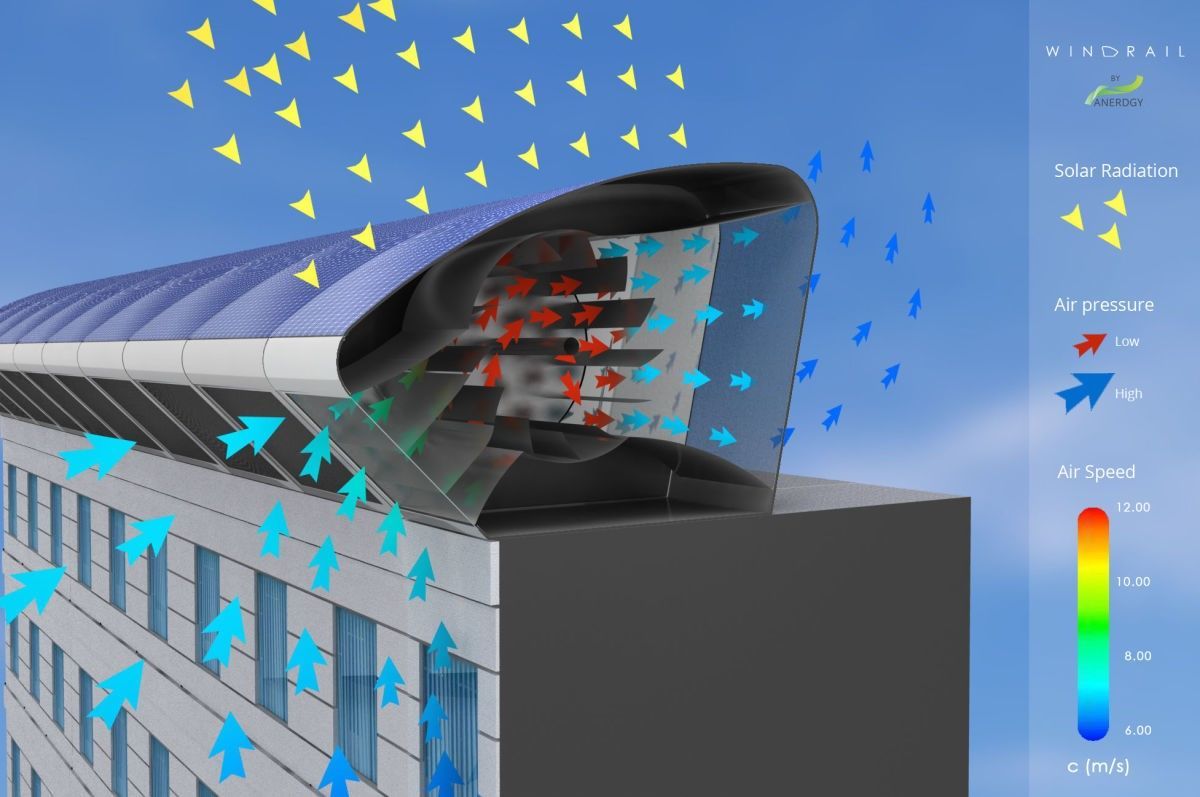Building-integrated wind turbine technology has been receiving a lot of heat for not being able to deliver what it promises in terms of energy production.
Fast Co. Exist profiles a system that places the turbines where they can actually turn. The WindRail was designed in Zurich, Switzerland, where there isn’t enough space for a wind or solar park. Sitting between a building’s façade and the roof edge, the system combines wind and solar energy harvesting, taking advantage of the building’s air flows, even if it's in the middle of a city.
The system was developed by the Anerdgy. “When wind flows around the building, it creates a pressure difference between the façade and the rooftop. The façade has a higher wind pressure,” CEO of Anerdgy Sven Koehler told Fast Co. Exist. “Because we are channeling the wind and making a connection between the high and low pressure areas, the speeds are faster and we have more energy.”
Koehler, an engineer and economist, came up with the idea with the help of his parents. After years of research, he came up with the WindRail System and started the company in 2012.
According to the company, pressure effect accounts for 50% of the power the WindRail generates. The device comes in two meter modules and can generate 1,500 to 2,000 kWh a year. For comparison, the average U.S. home uses 10,837 kWh a year, Fast Co. Exist reports.


Related Stories
Smart Buildings | Apr 28, 2014
Cities Alive: Arup report examines latest trends in urban green spaces
From vertical farming to glowing trees (yes, glowing trees), Arup engineers imagine the future of green infrastructure in cities across the world.
| Apr 16, 2014
Upgrading windows: repair, refurbish, or retrofit [AIA course]
Building Teams must focus on a number of key decisions in order to arrive at the optimal solution: repair the windows in place, remove and refurbish them, or opt for full replacement.
| Apr 15, 2014
Avoided energy use exceeds contribution of other fuels: IEA report
Avoided energy use attributable to energy-efficiency investments has resulted in a contribution outstripping the annual consumption of oil, natural gas, electricity, and coal.
| Mar 26, 2014
Callison launches sustainable design tool with 84 proven strategies
Hybrid ventilation, nighttime cooling, and fuel cell technology are among the dozens of sustainable design techniques profiled by Callison on its new website, Matrix.Callison.com.
| Mar 7, 2014
Thom Mayne's high-tech Emerson College LA campus opens in Hollywood [slideshow]
The $85 million, 10-story vertical campus takes the shape of a massive, shimmering aircraft hangar, housing a sculptural, glass-and-aluminum base building.
| Mar 6, 2014
AIA and almost 1,000 other businesses oppose effort to repeal energy efficiency bill
This opposition comes in response to reports that the oil and gas lobby pushed to include a repeal of Section 433 of the Energy Independence and Security Act in the bipartisan Shaheen-Portman energy efficiency bill.
| Feb 13, 2014
Extreme Conversion: Nazi bunker transformed into green power plant, war memorial
The bunker, which sat empty for over 60 years after WWII, now uses sustainable technology and will provide power to about 4,000 homes.
| Jan 30, 2014
How reverse engineering nature can spur design innovation
It’s not enough to copy nature. Today’s designers need a deeper understanding of environmental nuance, from the biome in.
| Jan 23, 2014
Adrian Smith + Gordon Gill-designed Federation of Korean Industries tower opens in Seoul [slideshow]
The 50-story tower features a unique, angled building-integrated photovoltaic (BIPV) exterior designed to maximize the amount of energy collected.
| Jan 16, 2014
The incandescent light bulb is not dead
Despite misleading media reports, January 1 did not mark a ban on the manufacture or import of 60-watt and 40-watt incandescent bulbs.

















